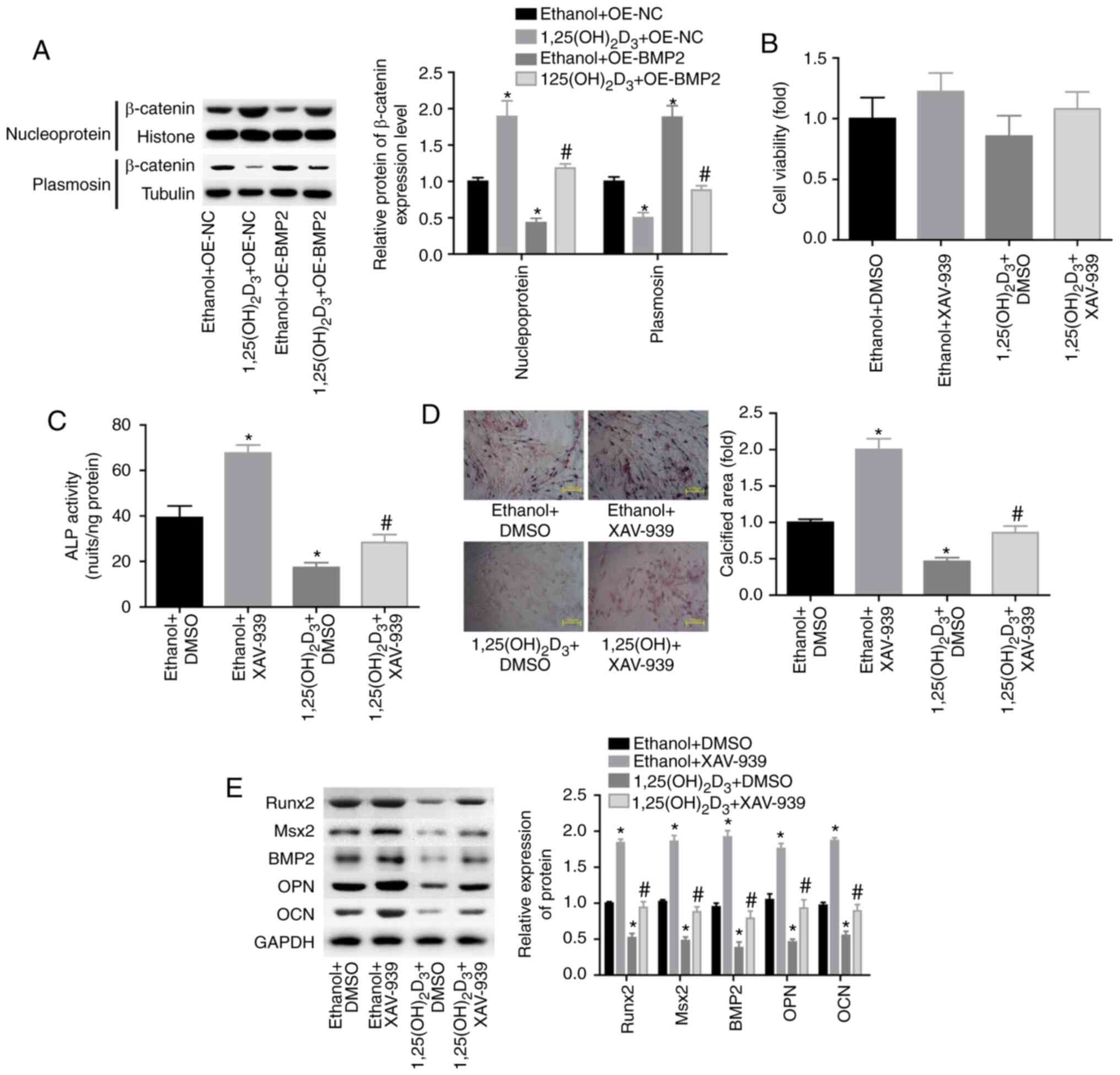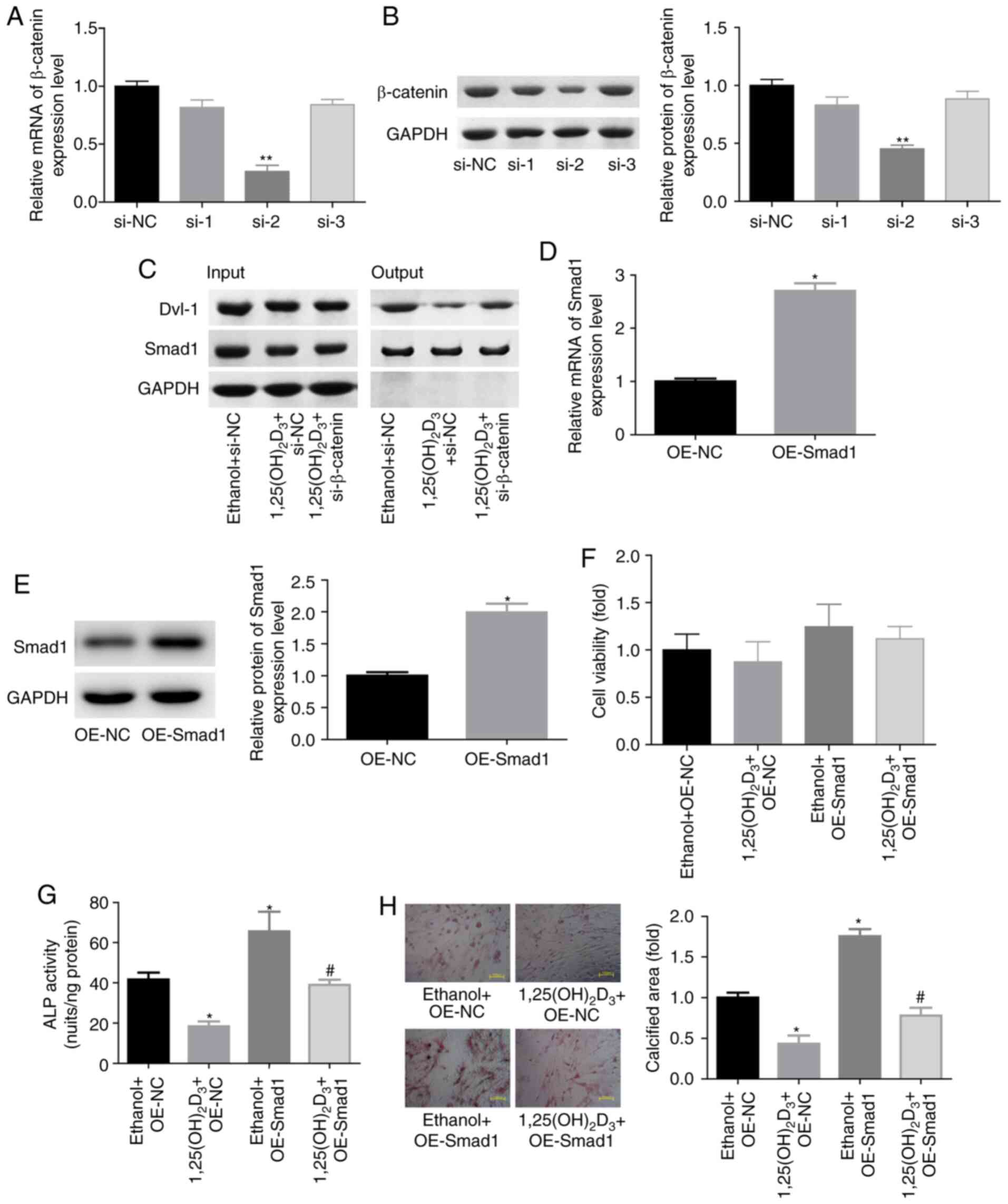|
1
|
Raisz LG: Pathogenesis of osteoporosis:
Concepts, conflicts, and prospects. J Clin Invest. 115:3318–3325.
2005. View Article : Google Scholar : PubMed/NCBI
|
|
2
|
Kanis JA, McCloskey EV, Johansson H and
Oden A: Approaches to the targeting of treatment for osteoporosis.
Nat Rev Rheumatol. 5:425–431. 2009. View Article : Google Scholar : PubMed/NCBI
|
|
3
|
Hayashi M, Nakashima T, Yoshimura N,
Okamoto K, Tanaka S and Takayanagi H: Autoregulation of osteocyte
Sema3A orchestrates estrogen action and counteracts bone aging.
Cell Metab. 29:627–637.e625. 2019. View Article : Google Scholar : PubMed/NCBI
|
|
4
|
Yu Y, Newman H, Shen L, Sharma D, Hu G,
Mirando AJ, Zhang H, Knudsen E, Zhang GF, Hilton MJ and Karner CM:
Glutamine metabolism regulates proliferation and lineage allocation
in skeletal stem cells. Cell Metab. 29:966–978 e964. 2019.
View Article : Google Scholar : PubMed/NCBI
|
|
5
|
Shoback D: Update in osteoporosis and
metabolic bone disorders. J Clin Endocrinol Metab. 92:747–753.
2007. View Article : Google Scholar : PubMed/NCBI
|
|
6
|
Rosen CJ and Bouxsein ML: Mechanisms of
disease: Is osteoporosis the obesity of bone? Nat Clin Pract
Rheumatol. 2:35–43. 2006. View Article : Google Scholar : PubMed/NCBI
|
|
7
|
Rosen CJ, Ackert-Bicknell C, Rodriguez JP
and Pino AM: Marrow fat and the bone microenvironment:
Developmental, functional, and pathological implications. Crit Rev
Eukaryot Gene Expr. 19:109–124. 2009. View Article : Google Scholar : PubMed/NCBI
|
|
8
|
Fan Y, Hanai JI, Le PT, Bi R, Maridas D,
DeMambro V, Figueroa CA, Kir S, Zhou X, Mannstadt M, et al:
Parathyroid hormone directs bone marrow mesenchymal cell fate. Cell
Metab. 25:661–672. 2017. View Article : Google Scholar : PubMed/NCBI
|
|
9
|
Ren R, Ocampo A, Liu GH and Izpisua
Belmonte JC: Regulation of stem cell aging by metabolism and
epigenetics. Cell Metab. 26:460–474. 2017. View Article : Google Scholar : PubMed/NCBI
|
|
10
|
Jurutka PW, Whitfield GK, Hsieh JC,
Thompson PD, Haussler CA and Haussler MR: Molecular nature of the
vitamin D receptor and its role in regulation of gene expression.
Rev Endocr Metab Disord. 2:203–216. 2001. View Article : Google Scholar : PubMed/NCBI
|
|
11
|
Fu B, Wang H, Wang J, Barouhas I, Liu W,
Shuboy A, Bushinsky DA, Zhou D and Favus MJ: Epigenetic regulation
of BMP2 by 1,25-dihydroxyvitamin D3 through DNA methylation and
histone modification. PLoS One. 8:e614232013. View Article : Google Scholar : PubMed/NCBI
|
|
12
|
DeLuca HF: The vitamin D story: A
collaborative effort of basic science and clinical medicine. FASEB
J. 2:224–236. 1988. View Article : Google Scholar : PubMed/NCBI
|
|
13
|
Erben RG, Scutt AM, Miao D, Kollenkirchen
U and Haberey M: Short-term treatment of rats with high dose
1,25-dihydroxyvitamin D3 stimulates bone formation and increases
the number of osteoblast precursor cells in bone marrow.
Endocrinology. 138:4629–4635. 1997. View Article : Google Scholar : PubMed/NCBI
|
|
14
|
Erben RG, Bromm S and Stangassinger M:
Therapeutic efficacy of 1alpha,25-dihydroxyvitamin D3 and calcium
in osteopenic ovariectomized rats: Evidence for a direct anabolic
effect of 1alpha,25-dihydroxyvitamin D3 on bone. Endocrinology.
139:4319–4328. 1998. View Article : Google Scholar : PubMed/NCBI
|
|
15
|
Sooy K, Sabbagh Y and Demay MB:
Osteoblasts lacking the vitamin D receptor display enhanced
osteogenic potential in vitro. J Cell Biochem. 94:81–87. 2005.
View Article : Google Scholar : PubMed/NCBI
|
|
16
|
Yamaguchi M and Weitzmann MN: High dose
1,25(OH)2D3 inhibits osteoblast mineralization in vitro. Int
J Mol Med. 29:934–938. 2012.PubMed/NCBI
|
|
17
|
Monroe DG, McGee-Lawrence ME, Oursler MJ
and Westendorf JJ: Update on Wnt signaling in bone cell biology and
bone disease. Gene. 492:1–18. 2012. View Article : Google Scholar : PubMed/NCBI
|
|
18
|
Liu N, Shi S, Deng M, Tang L, Zhang G, Liu
N, Ding B, Liu W, Liu Y, Shi H, et al: High levels of β-catenin
signaling reduce osteogenic differentiation of stem cells in
inflammatory microenvironments through inhibition of the
noncanonical Wnt pathway. J Bone Miner Res. 26:2082–2095. 2011.
View Article : Google Scholar : PubMed/NCBI
|
|
19
|
Mo J, Yang R, Li F, He B, Zhang X, Zhao Y,
Shen Z and Chen P: Geraniin promotes osteogenic differentiation of
bone marrow mesenchymal stem cells (BMSCs) via activating
β-catenin: A comparative study between BMSCs from normal and
osteoporotic rats. J Nat Med. 73:262–272. 2019. View Article : Google Scholar : PubMed/NCBI
|
|
20
|
Gnecchi M and Melo LG: Bone marrow-derived
mesenchymal stem cells: Isolation, expansion, characterization,
viral transduction, and production of conditioned medium. Methods
Mol Biol. 482:281–294. 2009. View Article : Google Scholar : PubMed/NCBI
|
|
21
|
Li P, Kong J, Chen Z, Huang S, Lv G, Wei
B, Wei J, Jing K, Quan J and Chu J: Aloin promotes osteogenesis of
bone-marrow-derived mesenchymal stem cells via the ERK1/2-dependent
Runx2 signaling pathway. J Nat Med. 73:104–113. 2019. View Article : Google Scholar : PubMed/NCBI
|
|
22
|
Schmittgen TD and Livak KJ: Analyzing
real-time PCR data by the comparative C(T) method. Nat Protoc.
3:1101–1108. 2008. View Article : Google Scholar : PubMed/NCBI
|
|
23
|
Yoshida M, Ishimura A, Terashima M,
Enkhbaatar Z, Nozaki N, Satou K and Suzuki T: PLU1 histone
demethylase decreases the expression of KAT5 and enhances the
invasive activity of the cells. Biochem J. 437:555–564. 2011.
View Article : Google Scholar : PubMed/NCBI
|
|
24
|
Haramis AP, Begthel H, van den Born M, van
Es J, Jonkheer S, Offerhaus GJ and Clevers H: De novo crypt
formation and juvenile polyposis on BMP inhibition in mouse
intestine. Science. 303:1684–1686. 2004. View Article : Google Scholar : PubMed/NCBI
|
|
25
|
You L, Pan L, Chen L, Gu W and Chen J:
MiR-27a is Essential for the Shift from osteogenic differentiation
to adipogenic differentiation of mesenchymal stem cells in
postmenopausal osteoporosis. Cell Physiol Biochem. 39:253–265.
2016. View Article : Google Scholar : PubMed/NCBI
|
|
26
|
Tella SH and Gallagher JC: Prevention and
treatment of postmenopausal osteoporosis. J Steroid Biochem Mol
Biol. 142:155–170. 2014. View Article : Google Scholar : PubMed/NCBI
|
|
27
|
Zou W, Greenblatt MB, Brady N, Lotinun S,
Zhai B, de Rivera H, Singh A, Sun J, Gygi SP, Baron R, et al: The
microtubule-associated protein DCAMKL1 regulates osteoblast
function via repression of Runx2. J Exp Med. 210:1793–1806. 2013.
View Article : Google Scholar : PubMed/NCBI
|
|
28
|
Wang EA, Rosen V, D'Alessandro JS, Bauduy
M, Cordes P, Harada T, Israel DI, Hewick RM, Kerns KM, LaPan P, et
al: Recombinant human bone morphogenetic protein induces bone
formation. Proc Natl Acad Sci USA. 87:2220–2224. 1990. View Article : Google Scholar : PubMed/NCBI
|
|
29
|
Harris SE, Bonewald LF, Harris MA,
Sabatini M, Dallas S, Feng JQ, Ghosh-Choudhury N, Wozney J and
Mundy GR: Effects of transforming growth factor beta on bone nodule
formation and expression of bone morphogenetic protein 2,
osteocalcin, osteopontin, alkaline phosphatase, and type I collagen
mRNA in long-term cultures of fetal rat calvarial osteoblasts. J
Bone Miner Res. 9:855–863. 1994. View Article : Google Scholar : PubMed/NCBI
|
|
30
|
Leyssens C, Verlinden L and Verstuyf A:
Antineoplastic effects of 1,25(OH)2D3 and its analogs in breast,
prostate and colorectal cancer. Endocr Relat Cancer. 20:R31–R47.
2013. View Article : Google Scholar : PubMed/NCBI
|
|
31
|
Tagami T, Lutz WH, Kumar R and Jameson JL:
The interaction of the vitamin D receptor with nuclear receptor
corepressors and coactivators. Biochem Biophys Res Commun.
253:358–363. 1998. View Article : Google Scholar : PubMed/NCBI
|
|
32
|
Larriba MJ, González-Sancho JM, Barbáchano
A, Niell N, Ferrer-Mayorga G and Muñoz A: Vitamin D is a multilevel
repressor of Wnt/b-catenin signaling in cancer cells. Cancers
(Basel). 5:1242–1260. 2013. View Article : Google Scholar : PubMed/NCBI
|
|
33
|
Pálmer HG, González-Sancho JM, Espada J,
Berciano MT, Puig I, Baulida J, Quintanilla M, Cano A, de Herreros
AG, Lafarga M and Muñoz A: Vitamin D(3) promotes the
differentiation of colon carcinoma cells by the induction of
E-cadherin and the inhibition of beta-catenin signaling. J Cell
Biol. 154:369–387. 2001. View Article : Google Scholar : PubMed/NCBI
|
|
34
|
Larriba MJ, Valle N, Pálmer HG,
Ordóñez-Morán P, Alvarez-Díaz S, Becker KF, Gamallo C, de Herreros
AG, González-Sancho JM and Muñoz A: The inhibition of
Wnt/beta-catenin signalling by 1alpha,25-dihydroxyvitamin D3 is
abrogated by Snail1 in human colon cancer cells. Endocr Relat
Cancer. 14:141–151. 2007. View Article : Google Scholar : PubMed/NCBI
|
|
35
|
Chang J, Sonoyama W, Wang Z, Jin Q, Zhang
C, Krebsbach PH, Giannobile W, Shi S and Wang CY: Noncanonical
Wnt-4 signaling enhances bone regeneration of mesenchymal stem
cells in craniofacial defects through activation of p38 MAPK. J
Biol Chem. 282:30938–30948. 2007. View Article : Google Scholar : PubMed/NCBI
|
|
36
|
Luo X, Li HX, Liu RX, Wu ZS, Yang YJ and
Yang GS: Beta-catenin protein utilized by Tumour necrosis
factor-alpha in porcine preadipocytes to suppress differentiation.
BMB Rep. 42:338–343. 2009. View Article : Google Scholar : PubMed/NCBI
|
|
37
|
Daoussis D, Andonopoulos AP and Liossis
SN: Wnt pathway and IL-17: Novel regulators of joint remodeling in
rheumatic diseases. Looking beyond the RANK-RANKL-OPG axis. Semin
Arthritis Rheum. 39:369–383. 2010. View Article : Google Scholar : PubMed/NCBI
|
|
38
|
Derfoul A, Carlberg AL, Tuan RS and Hall
DJ: Differential regulation of osteogenic marker gene expression by
Wnt-3a in embryonic mesenchymal multipotential progenitor cells.
Differentiation. 72:209–223. 2004. View Article : Google Scholar : PubMed/NCBI
|
|
39
|
Bilic J, Huang YL, Davidson G, Zimmermann
T, Cruciat CM, Bienz M and Niehrs C: Wnt induces LRP6 signalosomes
and promotes dishevelled-dependent LRP6 phosphorylation. Science.
316:1619–1622. 2007. View Article : Google Scholar : PubMed/NCBI
|
|
40
|
MacDonald BT, Tamai K and He X:
Wnt/beta-catenin signaling: Components, mechanisms, and diseases.
Dev Cell. 17:9–26. 2009. View Article : Google Scholar : PubMed/NCBI
|
|
41
|
Niehrs C and Shen J: Regulation of Lrp6
phosphorylation. Cell Mol Life Sci. 67:2551–2562. 2010. View Article : Google Scholar : PubMed/NCBI
|


















